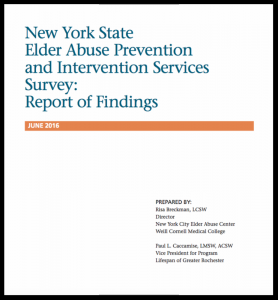
All states have guardianship laws (sometimes known as conservator laws) to protect adults who are unable to make decisions for themselves, such as medical treatment and financial decisions More →
 How adequate are New York State’s services for elder abuse victims?
How adequate are New York State’s services for elder abuse victims?
This report has the answer.
Wouldn’t it be great to have a comprehensive picture of the elder abuse prevention and intervention service gaps and barriers in your state? Wouldn’t this help to get a handle on where things could be improved around your state, so that someday (with sustained advocacy and, yes, adequate funding) the gaps would be filled in and the barriers to obtaining help for victims would be lowered?
Now, New York State has these answers. Elder justice stakeholders in NYS responded to a survey developed by the NYC Elder Abuse Center (NYCEAC) and Lifespan of Greater Rochester, Inc. to assess the current adequacy of elder abuse victim prevention and intervention services around the state. The findings from the survey can be found in the newly released report, NYS Elder Abuse Prevention and Intervention Services Survey: Report of Findings. (The report was prepared by Risa Breckman, LCSW, Director, NYCEAC, and Paul L. Caccamise, LMSW, ACSW, Vice President for Program at Lifespan.)
A “striking” array of gaps and barriers were identified…but equally important: respondents suggested an impressive number of solutions.
The purpose of the survey, to which 484 individuals across NY State responded, was to obtain granular feedback about the state of elder abuse services across multiple service systems. All counties except two, plus the Seneca nation, were represented. The majority of respondents reported on a county or regional, versus statewide, basis. Their function within their organizations varied, from front-line service providers to administrators.
Here are a few of the notable findings, broadly stated:
“We hope the findings will spark conversations with people within and across the many organizations and systems involved with preventing and responding to elder abuse,” said report co-authors Breckman and Caccamise. “We also hope that the information will be valuable to all those interested in improving, designing, expanding, and/or funding elder abuse victim prevention and intervention services in NYS.”
By Marilyn Harris
Marilyn Harris is an independent writer and editor specializing in business, technology, legal, and social issues.

All states have guardianship laws (sometimes known as conservator laws) to protect adults who are unable to make decisions for themselves, such as medical treatment and financial decisions More →

Bonnie Brandl and Cailin Crockett, leaders in the cause to end violence and abuse against older women, may be an unlikely intergenerational pairing, but in fact they are a powerful combination whose collaboration has enriched the field of elder justice. More →

Welcome to the NYC Elder Abuse Center’s (NYCEAC) Field Guide: News and Resources for Elder Justice Professionals blog. We've selected and analyzed the most helpful articles and resources relevant to elder justice professionals for July and August 2016. More →
Elder justice stakeholders in NYS responded to a survey developed by the NYC Elder Abuse Center (NYCEAC) and Lifespan of Greater Rochester, Inc. to assess the current adequacy of elder abuse victim prevention and intervention services around the state. The findings from the survey can be found in the newly released report, New York State Elder Abuse Prevention and Intervention Survey: Report of Findings. More →
“We wanted to emphasize that elder abuse happens every day, everywhere in the City, and that it ‘hits close to home,’ as the ads say,” explains Resnick. “We wanted people to understand that you don’t have to be in a nursing home, or be poor or have dementia to be an elder abuse victim. Because elder abuse is so often perpetrated by family members, anyone is vulnerable. And we wanted to get the message across that it could be happening to a neighbor, a friend, to their own older relative.” More →